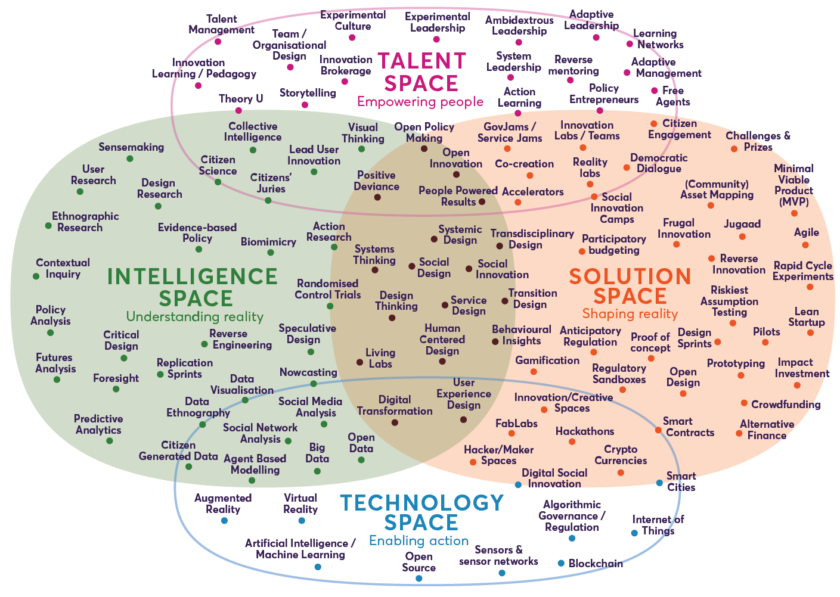The number of innovation methods available can be confusing and daunting. We’ve mapped out the various methods and approaches we’ve come across to help people explore and make sense of the broad range of methods that exist. We’ve included new approaches since our first version.
Earlier this year we presented our landscape of innovation approaches. Since publishing this diagram we’ve received many helpful comments and suggestions. We’ve also created a list of approaches not already on the map; a combination of emerging methods and new to us approaches. Which brings us to version 2 of the landscape.
Below the updated diagram we’ve included a full list of all the approaches, with new additions highlighted.
The full Landscape of innovation approaches. Download this diagram as a PDF.
We used the same structure as the previous version and grouped methods and approaches into four categories: intelligence, solution, technology and talent. These spaces reflect the premise that in order to create change, you need to understand reality, as well as develop solutions and interventions to have an effect on it. There is no formula to how the methods are positioned within these spaces. Instead, we have tried to group methods together that are closely related.
People requested more information about what each approach means and where they should go to learn more about them. For each method on the map, there is a description available somewhere on the internet. But these descriptions aren’t always clear. For newcomers to public innovation especially, we wanted to signpost useful references. This is particularly true when a method has a variety of meanings and there is no consensus among practitioners and theorists.
To provide some guidance and clarity in general, we have listed all the approaches below and added links to resources that provide a definition and introductory information. Some approaches – especially the emerging or unusual ones (e.g. reverse engineering, smart contracts) – are not always well described or documented. Whereas more established approaches may be subject to disagreement or nuances of interpretation. For example, the meaning and value of ‘design thinking’ has been fiercely disputed and criticised since it has grown in popularity.
For these more “controversial” approaches, we haven’t picked a side with the reference we’ve provided. Instead, we’ve tried to refer to resources that we consider accessible, that don’t require prior knowledge and that provide a comprehensive introduction or definition that is generally accepted.
Intelligence space
These approaches help you make sense of reality, understand causes and effects of issues, and identify opportunities. Activities are driven by an inquisitive and analytical mindset.
- Action Research
- Agent Based Modelling
- Big Data (PulseLab’s slidedeck on big data is also useful)
- Biomimicry (also see the Biomimicry Institute) [NEW]
- Citizen Generated Data (also see these case studies and this framework from Civicus)
- Citizen Science [NEW]
- Citizens’ Juries [NEW]
- Collective Intelligence (also see this book and Nesta’s Centre for CI Design)
- Contextual Inquiry
- Critical Design
- Data Ethnography
- Data Visualisation (also see this Nesta article)
- Design Research
- Ethnographic Research
- Evidence-based Policy (also see this guide from the Alliance of Useful Evidence and this collaborative)
- Foresight
- Futures Analysis (also see this toolkit from the UK’s Cabinet Office)
- Lead User Innovation ( also see this example)
- Nowcasting
- Open Data (also see this guide from PulseLab)
- Policy Analysis
- Predictive Analytics [NEW]
- Randomised Control Trials
- Replication Sprints [NEW]
- Reverse Engineering (also see this guide by COI)
- Sensemaking
- Social Media Analysis (also see this article from the Oxford Internet Institute)
- Social Network Analysis (also see this guide from the UK’s Home Office) [NEW]
- Speculative Design
- User research [NEW]
- Visual Thinking (also see this book by Dan Roam) [NEW]
Solutions space
These approaches help you test and develop solutions. Activities are driven by a generative and entrepreneurial mindset, aiming to shape reality.
- Accelerators (also see this example from the UAE)
- Agile (also see this manual on gov.uk) [NEW]
- Alternative Finance (also see this report from Nesta)
- Anticipatory Regulation
- Challenges & Prizes
- Citizen Engagement (and see this Wikipedia page)
- Co-creation
- (Community) Asset Mapping
- Crowdfunding (also see this Nesta article on crowdfunding public services and this Nesta page with links to various platforms)
- Crypto Currencies (also see this Nesta article on crypto currencies and crowdfunding)
- Democratic Dialogue
- Design Sprints (also see this article)
- FabLabs
- Frugal Innovation
- Gamification (also see this GovTech article and this guide from MJV Technology and Innovation)
- GovJams / Service Jams
- Hackathons (also see this guide by Joshua Tauberer, this Medium article and this example from Innovate UK)
- Hacker/Maker Spaces [NEW]
- Impact Investment
- Innovation Labs / Teams
- Innovation/Creative Spaces
- Jugaad
- Lean Startup (also see this book by Ann Mei Chang)
- Minimal Viable Product (MVP)
- Open Design
- Participatory budgeting (also see this article on The Long+Short) [NEW]
- People Powered Results [NEW]
- Pilots (also see this article from freeCodeCamp, or this web page) [NEW]
- Proof of concept (also see this article) [NEW]
- Prototyping (also see this article from Snook, these reflections and this article on prototyping for policy by Policy Lab)
- Rapid Cycle Experiments [NEW]
- Reality labs
- Regulatory Sandboxes (see this example in Dubai) [NEW]
- Reverse Innovation (Wikipedia)
- Riskiest Assumption Testing
- Smart Contracts [NEW]
- Social Innovation Camps (see this and this example from UNDP)
Intelligence - Solutions space
The crossover between the intelligence and solution space includes methods built on both mindsets. They aim to understand, as well as shape reality.
- Behavioural Insights (also see this guide by the Behavioural Insights Team)
- Design Thinking (also see this guide by Nesta & IDEO)
- Digital Transformation (alse see this article from FutureGov)
- Human Centered Design (also see this article from the US Digital Service and this article from Sabine Junginger)
- Living Labs
- Open Innovation (also see this Nesta report)
- Open Policy Making
- Positive Deviance (also see the Positive Deviance Initiative)
- Service Design (also see this manifesto by UK Gov’s design community, or check out this book and this playbook from the British Colombia government)
- Social Design (also see this guide from Lucy Kimbell and Joe Julier)
- Social Innovation (also see this EU programme, and the SIX platform) [NEW]
- Systemic Design (also see this guide from CoLab)
- Systems Thinking (also see this guide from the Waters Foundation, this primer by Donella Meadows, or this report by OECD’s OPSI team)
- Transdisciplinary Design
- Transition Design
- User Experience Design
Technology space
Approaches and technology that enable action and change, such as digital tools and data-related methods (at the intersection with the intelligence space).
- Algorithmic Governance / Regulation (also see this Nesta article)
- Artificial Intelligence / Machine Learning (also see this Nesta article)
- Augmented Reality (also see these articles from UNICEF)
- Blockchain
- Digital Social Innovation
- Internet of Things (also see the IoT Council)
- Open Source
- Sensors & sensor networks
- Smart Cities
- Virtual Reality (also see this article from TechCrunch)
Talent space
Approaches focused on mobilising talent, developing technical and leadership skills and increasing organisational readiness.
- Action Learning (here is an account of its origins) [NEW]
- Adaptive Leadership
- Adaptive Management
- Ambidextrous Leadership
- Experimental Culture
- Experimental Leadership
- Free Agents [NEW]
- Innovation Brokerage [NEW]
- Innovation Learning / Pedagogy
- Learning Networks [NEW]
- Policy Entrepreneurs [NEW]
- Reverse mentoring (also see this guide from Govloop and this reflection on ethnic minorities) [NEW]
- Storytelling (also see this guide from Ashoka) [NEW]
- System Leadership (also see this article from The Point People)
- Talent Management (also see this guide from The King’s Fund)
- Team / Organisational Design (also see this and this from The Ready, and this intro by Mollie West Duffy)
- Theory U [NEW]
We hope you have found this useful as a primer. As this map is a continual work in progress we look forward to your feedback to further improve it. Please get in touch with us through the States of Change twitter.

